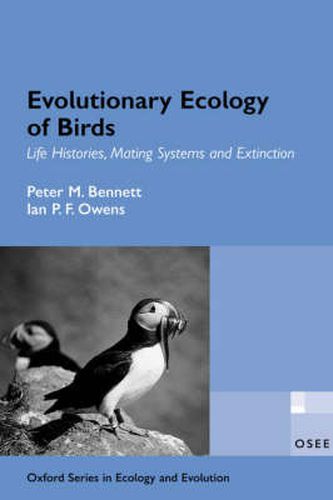Readings Newsletter
Become a Readings Member to make your shopping experience even easier.
Sign in or sign up for free!
You’re not far away from qualifying for FREE standard shipping within Australia
You’ve qualified for FREE standard shipping within Australia
The cart is loading…






Birds show bewildering diversity in their life histories, mating systems and risk of extinction. Why do albatrosses delay reproduction for the first 12 years of their life while zebra finches breed in their first year ? Why are fairy-wrens so sexually promiscuous while swans show lifelong monogamy? Why are over a quarter of parrot species threatened with global extinction while woodpeckers and cuckoos remain secure? Some of these topics, such as delayed onset of breeding in seabirds, are classic problems in evolutionary ecology, while others have arisen in the last decade, such as genetic mating systems and extinction. Birds offer a unique opportunity for investigating these questions because they are exceptionally well-studied in the wild. By employing phylogenetic comparative methods and a database of up to 3,000 species, the authors identify the ecological and evolutionary basis of many of these intriguing questions. They also highlight remaining puzzles and identify a series of challenges for future investigation. This is the most comprehensive reappraisal of avian diversity since David Lack’s classic Ecological Adaptations for Breeding in Birds . It is also the most extensive application of modern comparative methods yet undertaken. This novel approach demonstrates how an evolutionary perspective can reveal the general ecological processes that underpin contemporary avian diversity on a global scale.
$9.00 standard shipping within Australia
FREE standard shipping within Australia for orders over $100.00
Express & International shipping calculated at checkout
Stock availability can be subject to change without notice. We recommend calling the shop or contacting our online team to check availability of low stock items. Please see our Shopping Online page for more details.
Birds show bewildering diversity in their life histories, mating systems and risk of extinction. Why do albatrosses delay reproduction for the first 12 years of their life while zebra finches breed in their first year ? Why are fairy-wrens so sexually promiscuous while swans show lifelong monogamy? Why are over a quarter of parrot species threatened with global extinction while woodpeckers and cuckoos remain secure? Some of these topics, such as delayed onset of breeding in seabirds, are classic problems in evolutionary ecology, while others have arisen in the last decade, such as genetic mating systems and extinction. Birds offer a unique opportunity for investigating these questions because they are exceptionally well-studied in the wild. By employing phylogenetic comparative methods and a database of up to 3,000 species, the authors identify the ecological and evolutionary basis of many of these intriguing questions. They also highlight remaining puzzles and identify a series of challenges for future investigation. This is the most comprehensive reappraisal of avian diversity since David Lack’s classic Ecological Adaptations for Breeding in Birds . It is also the most extensive application of modern comparative methods yet undertaken. This novel approach demonstrates how an evolutionary perspective can reveal the general ecological processes that underpin contemporary avian diversity on a global scale.